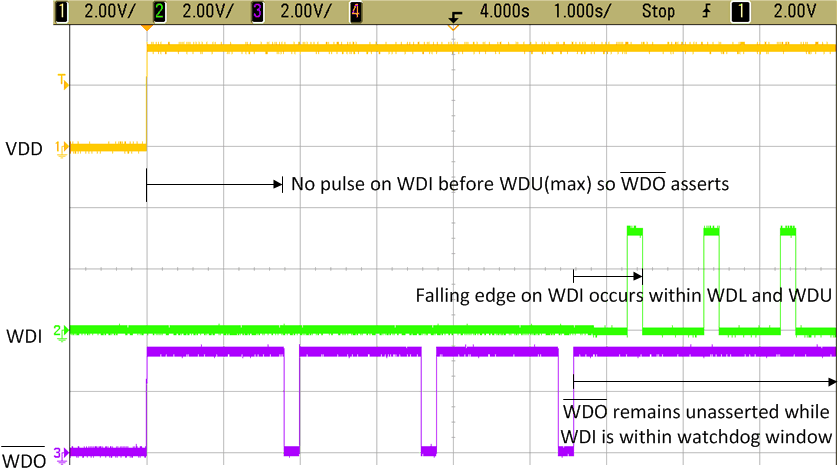SBVS366A July 2018 – October 2021 TPS3430
PRODUCTION DATA
- 1 Features
- 2 Applications
- 3 Description
- 4 Revision History
- 5 Pin Configuration and Functions
- 6 Specifications
- 7 Detailed Description
- 8 Application and Implementation
- 9 Power Supply Recommendations
- 10Layout
- 11Device and Documentation Support
- 12Mechanical, Packaging, and Orderable Information
Package Options
Mechanical Data (Package|Pins)
- DRC|10
Thermal pad, mechanical data (Package|Pins)
- DRC|10
Orderable Information
8.2.1.2.1 Meeting the Minimum Watchdog Reset Delay - Design 1
To achieve the 200 ms Watchdog Reset Delay requirement, this design simply leaves CRST pin floating (NC - No Connect) to set the Watchdog Reset Delay (tRST) to the factory-programmed delay of 200 ms. Refer to section 8.1.1 CRST Delay to learn more about the factory-programmed timing options and how to program the Watchdog Reset Delay using an external capacitor.
In Figure 8-4 below, the Watchdog Reset Delay of 200 ms is shown by causing a watchdog timing fault. No watchdog pulse comes on WDI within the Watchdog Timeout so WDO activates for tRST of 200 ms. Then after three watchdog faults, a watchdog pulse at 1Hz and 20% duty cycle arrives on WDI causing WDO to deactive and remain high.
 Figure 8-4 Watchdog Fault Caused by Missing WDI Pulse Until WDI pulses Arrive Within Watchdog Window to Deactivate
WDO Fault
Figure 8-4 Watchdog Fault Caused by Missing WDI Pulse Until WDI pulses Arrive Within Watchdog Window to Deactivate
WDO Fault